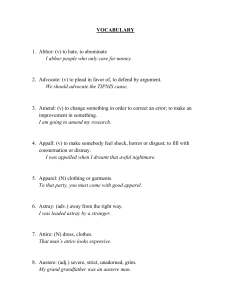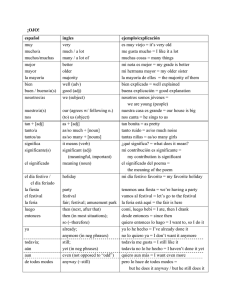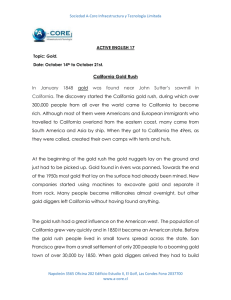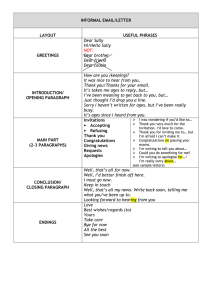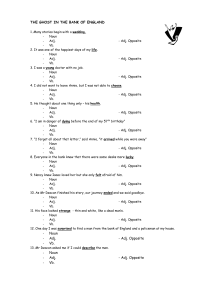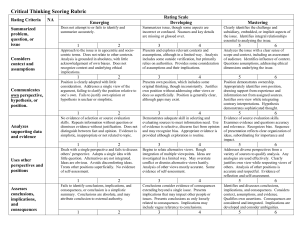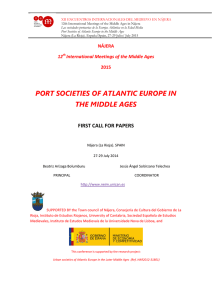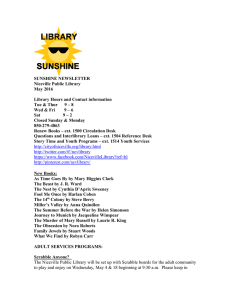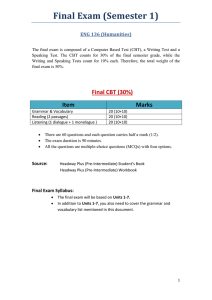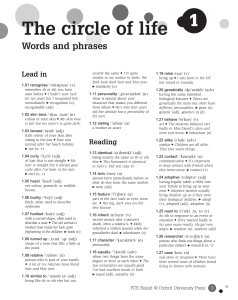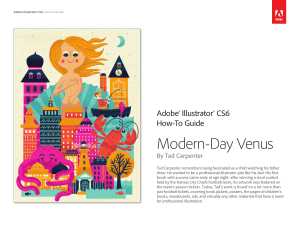Gold! - History (history.com)
Anuncio
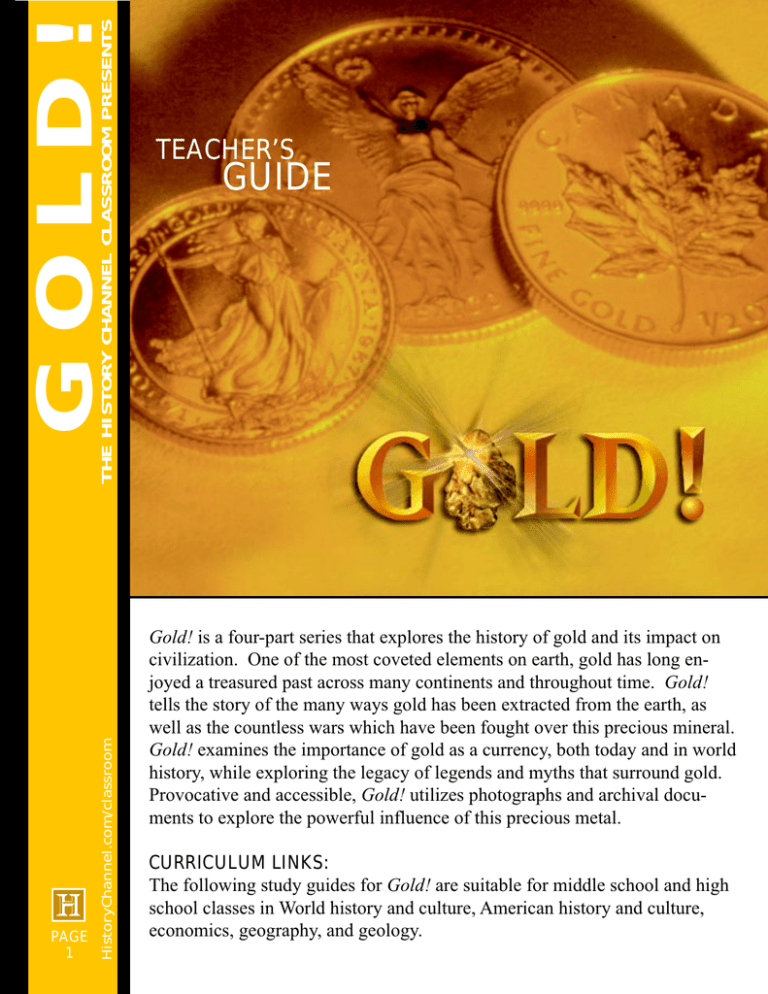
HistoryChannel.com/classroom THE HISTORY CHANNEL CLASSROOM PRESENTS GOLD! PAGE 1 TEACHER’S GUIDE Gold! is a four-part series that explores the history of gold and its impact on civilization. One of the most coveted elements on earth, gold has long enjoyed a treasured past across many continents and throughout time. Gold! tells the story of the many ways gold has been extracted from the earth, as well as the countless wars which have been fought over this precious mineral. Gold! examines the importance of gold as a currency, both today and in world history, while exploring the legacy of legends and myths that surround gold. Provocative and accessible, Gold! utilizes photographs and archival documents to explore the powerful influence of this precious metal. CURRICULUM LINKS: The following study guides for Gold! are suitable for middle school and high school classes in World history and culture, American history and culture, economics, geography, and geology. THE HISTORY CHANNEL CLASSROOM PRESENTS GOLD! GOLD!: GOLD FEVER The first episode of Gold! examines the phenomenon of the gold rush, from the lone prospector panning in the rivers of California to an army of miners tapping the deep mines of South Africa. Through much of time, gold mining was the province of monarchs, who enslaved conquered peoples to extract the metal. That changed radically in 1848, when gold was found at Sutter’s Mill in California. This discovery resulted in the first democratic gold rush, since anyone could hunt for his own pot of gold. Some 40,000 miners moved to the West, but most would not become rich. In fact, the average take in 1849 was just $250. Gold Fever uses extensive photos and archival documents to capture the frenzy of the California gold rush and other famous outbreaks of gold fever. NATIONAL HISTORY STANDARDS The study guide for Gold Fever fulfills the following National Standards for History as developed by the National Center for History in the Schools: Historical Thinking Standards 1, 2, 3, 4, and 5 for United States History (Era 4, Standards 1 and 2). OBJECTIVES Students will be able to chronicle the discovery of gold in California and describe its impact on the development of California and the West. Students will be able to compare and contrast the nature and impact of gold rushes in California, Alaska, Australia, and South Africa. Students will be able to explain how technological developments have influenced the mining of gold. VOCABULARY (v.) accumulate (n.) the solid rock that lies under the soil and other loose material on the surface of the earth drove (n.) a large mass of people moving or acting as a group entrepreneur (n.) a person who organizes and runs a business enterprise, taking on all the risk involved itinerant (adj.) traveling from place to place malleable (adj.) capable of being shaped, bent or drawn out; flexible mine (n.) a hole or passage dug in the earth to remove metals, coal, salt, or other minerals mint (n.) a place where the coins of a country are produced by the authority of the government prospector (n.) a person who explores an area for valuable mineral deposits or oil quartz (n.) a hard, transparent mineral; the most common of all minerals PAGE 2 HistoryChannel.com/classroom amass bedrock THE HISTORY CHANNEL CLASSROOM PRESENTS GOLD! GOLD!: GOLD FEVER DISCUSSION QUESTIONS 1. What specific object or place comes to your mind when you think of gold? Why is this object or place important to you and/or to history? 2. How do gold’s physical qualities help explain why it is so valuable? 3. With the help of an encyclopedia, James Sutter determined that the nuggets James Marshall found in 1848 were, in fact, nearly pure gold. Look up gold in an encyclopedia to see what Sutter might have learned in order to make this determination. 4. Who were the “forty-niners,” and why are they referred to by this name? 5. Describe the different journeys people took to get to the gold in California, Australia, and Alaska. Why were so many people willing to travel so far and endure such hardship? 6. How was California’s gold rush, unlike previous ones, an “individual’s gold rush”? How did it differ from earlier discoveries of gold during the times of the Roman or Spanish empires, for example? 7. What were the positive and negative effects of the gold rushes in the West? How did they impact the development of the West? How did they impact the Indian populations? 8. What was life like in Leadville, the famous mining camp in Colorado? How might the absence of women in gold country have influenced life in mining camps? 9. How did technological advances usher in a renaissance in gold mining? How did finding and digging for gold become more efficient as a result of these developments? 10. How is South African gold different from gold in California, Australia, and Alaska? Describe the experience of the miners who work in South Africa today. EXTENDED ACTIVITIES PAGE 3 HistoryChannel.com/classroom 1. After doing research on the experiences of miners in the American West or Australia in the 1850s, or in South Africa today, create a short story, diary entry, poem, or essay depicting the miners’ experiences and hopes. 2. Create a map of the most important gold rush sites in the United States and Alaska between 1840 and 1900. Include the name of each site and the year when gold was struck. 3. Research one of the technological developments that improved the process of mining gold, and create a poster presentation explaining how the technology works and how it influenced mining. 4. Choose an artifact made out of gold from any period in history, and write an essay describing it and why it is important. THE HISTORY CHANNEL CLASSROOM PRESENTS GOLD! GOLD!: GOLD FEVER RESOURCES WEB SITES www.museumca.org/goldrush Oakland Museum of California offers an online virtual tour of the museum’s exhibitions on the California gold rush. www.ballarat.edu.au/external/sovhill/gold150/gold150.htm Ballarat University has put together a collection of images and documents to celebrate the 150th anniversary of the Australian gold rush. www.bullion.org.za/bulza/educatn/educatio.htm The Chamber of Mines of South Africa education resources page explores the importance of gold mining to South Africa and includes fascinating facts about South African gold mining. BOOKS Blashfield, Jean F. The California Gold Rush. Minneapolis, Minn.: Compass Point Books, 2000. Reading Level: Ages 9 -12. Holliday, J. S. The World Rushed In: The California Gold Rush Experience. New York: Simon & Schuster, 1983. PAGE 4 HistoryChannel.com/classroom Stein, R.Conrad. The California Gold Rush. (Cornerstones of Freedom) Chicago: Children’s Press, 1995. Reading Level: Ages 9-12. THE HISTORY CHANNEL CLASSROOM PRESENTS GOLD! GOLD!: THE GOLD WARS The second episode of Gold! examines how the desire and lust for gold has fueled wars throughout history. Because of humankind’s greed and thirst for power, the quest for gold has resulted in untold numbers of lost lives. From the earliest days of ancient empires to the explorations of the New World, the search for this precious yellow metal has been a catalyst in historic events and the rise and fall of some of the world’s mightiest empires. OBJECTIVES Students will be able to identify the role gold has played as an agent in important events of world history. Students will explore how the quest for gold created and destroyed empires, and fueled the exploration of the New World. NATIONAL HISTORY STANDARDS The study guide for The Gold Wars fulfills the following National Standards for History as developed by the national Center for History in the Schools: Historical Thinking Standards 1, 2, 3, and 4 for United States History (Eras 1, 5 and 6) and World History (Eras 6 and 7). VOCABULARY mesmerize elaborate fanfare illiterate succumb PAGE 5 HistoryChannel.com/classroom ordain grueling pact prosperous austerity ideological nemesis (v.) to spellbind, hypnotize, or fascinate (adj.) complicated and detailed; having many parts (n.) a spectacular or impressive public display (adj.) unable to read or write (v.) to submit to an overpowering force or yield to an overwhelming desire; give up or give in (v.) to appoint as a minister, priest, or rabbi; to order or decree (adj.) physically or mentally demanding to the point of exhaustion (n.) a formal agreement; a bargain (adj.) having success; flourishing (n.) a way of living without extras or comforts; strictness or harsh discipline (adj.) of or concerned with ideas (n.) an opponent that cannot be beaten or overcome THE HISTORY CHANNEL CLASSROOM PRESENTS GOLD! GOLD!: THE GOLD WARS DISCUSSION QUESTIONS 11. Gold is recognized in history as one of the most valuable resources and precious metals. Yet you can’t eat it, it won’t keep you warm, and it cannot provide shelter. What makes gold so valuable? 12. Explorers in the fifteenth century embarked from various European countries on dangerous voyages. How did gold fuel this frenzy of exploration which resulted in the invasion of the New World? 13. Indigenous people of North and South America are still known as Indians, the name Christopher Columbus bestowed on them. Why did Columbus call the people he encountered in the New World Indians? 14. Portugal and Spain squabbled over rights to different territories in the New World. How did the Catholic Church settle this dispute? What was the end result? 15. What role did disease play in the decline of the indigenous populations of the New World? 16. The Spanish Conquistadors looted, plundered, and murdered their way through the New World. How did the Conquistadors justify their behavior? 17. Who was Atahualpa? What was his role in world history? 18. The Spanish Conquistadors destroyed the Incas, even though the Spanish were vastly outnumbered. Discuss the differences in the warfare technology between the Incas and the Spaniards that enabled this defeat. 19. At the end of his life, Atahualpa converted to Christianity. Why? 10. What led to the decline of Spain as a world power in the sixteenth century? 11. How did the United States government treat the Native Americans in the Black Hills? 12. What were the causes and outcomes of the Boer War? PAGE 6 HistoryChannel.com/classroom EXTENDED ACTIVITIES 1. Imagine that you are a Conquistador or an Incan during the conquest of the Incan Empire. Write a letter or journal entry about your experiences. Then change character, and write a letter or journal entry from the other perspective. How did your writing change? 2. Research Incan ceremonial items on the Internet and create an artistic presentation of your findings. How was the item(s) you chose used? What does it tell you about Incan culture? THE HISTORY CHANNEL CLASSROOM PRESENTS GOLD! GOLD!: THE GOLD WARS RESOURCES WEB SITES www.gold.org/Ginfos/Gi1anc.htm The World Gold Council’s history of Pizarro and Atahualpa in the New World. www.gold.org/Ginfos/Gi2pro.htm The World Gold Council’s history of Gold production around the world. www.nara.gov/exhall/originals/sioux.html The National Archives and Record Administration’s virtual exhibit of the Black Hills Treaty. PAGE 7 HistoryChannel.com/classroom BOOKS Gold, Susan Dudley. Indian Treaties. (Pacts and Treaties) Twenty First Century Books, 1997. Reading Level: Ages 9-12. Mann, Elizabeth, and Amy Crehore (Illustrator). Macchu Picchu: The Story of the Amazing Incas and Their City in the Clouds. (Wonders of the World Book) Mikaya Press, 2000. Reading level: Ages 9-12. Millar, Heather. Spain in the Age of Exploration. (Cultures of the Past) Marshall Cavendish Corp., 1999. Reading Level: Ages 9-12. Weisberg, Barbara, Alex Haley, and Michael Eagle (Illustrator). Coronado’s Golden Quest. (Stories of America) Raintree/Steck-Vaughn, 1996. Reading Level: Ages 9-12. Worth, Richard. Pizarro and the Conquest of the Incan Empire in World History. (In World History) Enslow Publishers, Inc., 2000. Reading level: Ages 9-12. THE HISTORY CHANNEL CLASSROOM PRESENTS GOLD! GOLD!: COLD HARD CASH The third episode of Gold! explores the role gold has played as currency throughout world history. From the first gold coins minted in Sardis to the gold backed greenbacks to international gold markets, gold, whether physically or ideologically represented, has been the cornerstone of currency for thousands of years. Even today, when most financial transactions are merely electronic blips, there is still a connection to gold. The value of paper money is still decided when the market determines how many dollars, yen, or pounds are necessary to purchase an ounce of gold. OBJECTIVES Students will examine the role gold has played as a form of currency in world history. Students will explore and analyze methods of exchange and how the value of money is established. NATIONAL HISTORY STANDARDS The study guide for Cold Hard Cash fulfills the following National Standards for History as developed by the National Center for History in the Schools: Historical Thinking Standards 1, 2, 3, and 4 for United States History (Eras 1 through 10) and World History (Eras 3 through 9). VOCABULARY odyssey realm brazen vendetta vilify ransack maritime prestige obsolet concoct promissory note PAGE 8 HistoryChannel.com/classroom abstract (n.) a long voyage or trip usually full of adventure (n.) a kingdom, community, or territory (adj.) rudely bold; insolent (n.) a bitter, destructive feud (v.) to make degrading and vicious statements about (v.) to rob of valuables and leave in disorder; pillage (adj.) on or near the sea; marine shipping or navigation (n.) the level of respect at which one is regarded by others; standing (adj.) outdated in design, style, or construction; no longer useful (v.) to create, using skill and intelligence; contrive (n.) a written promise to pay to a certain sum of money to a person named, at a specific time or on demand (adj.) based on ideas; hard to understand THE HISTORY CHANNEL CLASSROOM PRESENTS GOLD! GOLD!: COLD HARD CASH DISCUSSION QUESTIONS 11. Gold is called the “universal currency” of wealth and power. Why is it universal? Why and how does it transcend economic, social, as well as physical borders? 12. Before the advent of currency, most locales used a system of barter. What is a barter system? How does a barter system work? Have you ever used the barter system? 13. Why did trade evolve from barter to a form of currency? Why did gold emerge as the preferred form of currency? 14. What is a numismatist? How would you define this occupation? 15. The first gold coins were minted in Sardis. How did the gold coins of Sardis facilitate trade between eastern and western civilizations? 16. The Roman Empire was one of the most powerful empires of the ancient world. How did gold help build the empire? 17. How have Christianity and gold been connected? 18. The Venetian Empire was the seat of economic power in the late Middle Ages and the Renaissance. How did geography assist the Venetian Empire in achieving and maintaining its power? 19. Venetians and French Crusaders attacked Constantinople. Why? 10. What was the impetus for Christopher Columbus’s voyage in the late fifteenth century? 11. In 1848, gold was discovered at Sutter’s Mill in California. How did this gold strike boost the American economy? 12. In 1857 there was an economic recession. What caused this recession? 13. How did the greenback differ from other forms of paper money? 14. What is a congressional fiat? PAGE 9 HistoryChannel.com/classroom EXTENDED ACTIVITIES 1. Research different forms of gold or money backed by gold in the world, and use your data to create a pictorial representation. 2. Imagine that you are a ruler of country. Create a gold coin for use as your country’s currency. 3. Follow this link to Christopher Columbus’s letter to the King and Queen of Spain www.ukans.edu/carrie/docs/texts/columlet.html discussing gold in the New World. Write a response from the King and Queen of Spain. THE HISTORY CHANNEL CLASSROOM PRESENTS GOLD! GOLD!: COLD HARD CASH RESOURCES WEB SITES www.taxfreegold.co.uk/goldcoinsbriefhistory.html A brief history of gold coins from the Tax Free Gold Web site. www.math.montana.edu/~umsfwest/numis/ Ancient Roman and Greek coins from the University of Montana. www.americaslibrary.gov/pages/jb_0824_goldlost_1.html The story of the Panic of 1857 from the Library of Congress. PAGE 10 HistoryChannel.com/classroom minneapolisfed.org/econed/curric/history.html A history of money from the Federal Reserve Bank of Minneapolis. BOOKS Chrisp, Peter. The Roman Empire. Two-Can Publishers, 2001. Reading Level: Ages 9-12. Geography Department. Sold!: The Origins of Money and Trade. (Buried Worlds) Runestone Press, 1994. Reading Level: Ages 9-12. Henty, G.A., and Gordon Browne (Illustrator). The Lion of St. Mark: A Tale of Venice in the 14th Century. Preston Speed Publications, 2000. Reading Level: Ages 9-12. Maestro, Betsy C., and Giulio Maestro (Illustrator). The Story of Money. Clarion Books, 1993. Reading Level: Ages 9-12. THE HISTORY CHANNEL CLASSROOM PRESENTS GOLD! GOLD!: THE STUFF OF DREAMS The final episode of Gold! explores humankind’s quest for elusive gold treasures from biblical stories to high-tech treasure hunts. It examines the lure and seduction of the pot of gold at the end of the rainbow that has induced people to give up their time, money, resources, and sometimes even their lives, to obtain their dreams of hitting the mother lode. OBJECTIVES Students will explore how the legend and myths of gold have led people to extreme measures to find these elusive treasures. They will analyze the influence these myths and legends have had on archeology, exploration, and world history. NATIONAL HISTORY STANDARDS The study guide for The Stuff of Dreams fulfills the following National Standards for History developed by the National Center for History in the Schools: Historical Thinking Standards 1, 2, 3, and 4 for World History (Eras 3 through 9). VOCABULARY hypnotic Bedouin mirage caveat tantalize ruthless pueblo utopia PAGE 11 HistoryChannel.com/classroom aura fabricate seduce mollify (adj.) attracting and holding interest as if by a spell (n.) an Arab of any of the nomadic tribes of the Arabian, Syrian, Nubian, or Sahara deserts (n.) an illusion or deception in which a person mistakenly sees something that in reality does not exist (n.) a warning or explanation (v.) to tease or torment another by offering something desirable while keeping it out of reach (adj.) having no compassion or pity; merciless (n.) a permanent village or community of any of the Pueblo peoples, typically consisting of multilevel adobe or stone apartment dwellings of terraced design clustered around a central plaza (n.) an ideal and perfect place, especially in its social, political, and moral aspects (n.) a distinctive but intangible quality that seems to surround a person or thing; atmosphere (v.) to create in order to deceive (v.) to persuade someone into a desired state or position (v.) to calm pain or irritation; to appease excited feeling or passion; to pacify THE HISTORY CHANNEL CLASSROOM PRESENTS GOLD! GOLD!: THE STUFF OF DREAMS DISCUSSION QUESTIONS 1. Since biblical times, fortune hunters have searched for lost treasures. What makes people search for these treasures? What is the payoff of finding a treasure? 2. One of history’s legendary lost treasures is the Ark of the Covenant. What is the Ark of the Covenant? What is its religious as well as monetary value? 3. King Solomon built a glorious temple according to Biblical accounts. Why did he build this temple? 4. In 1947, a shepherd boy discovered the Dead Sea Scrolls in a cave. What was the significance of this find? 5. What is the controversy of the Copper Scroll? 6. Biblical archeologist Vendyl Jones has formulated some theories about the location of the Ark of the Covenant. Why do some scholars find his theories controversial? 7. In 1528, Spanish conquistadors embarked on a journey. What were these conquistadors looking for? 8. What was Coronado looking for in 1540 in the American Southwest? How did his journey end? 9. Some scholars speculate that Native Americans invented stories of golden cities for the Spaniards. Why do scholars think Native Americans may have done this? 10. What is the legend of El Dorado? 11. Discuss the life of Walter Raleigh. How did his greed determine the course of his life? 12. Fortune seekers have been searching for gold in the American Southwest for centuries. Why do so many believe that there is gold in this area? 13. Egyptian pyramids are testimonies to the advanced engineering skills of the ancient Egyptians. Why did Egyptians build these mighty structures? 14. What was the significance of the discovery of King Tut’s tomb? PAGE 12 HistoryChannel.com/classroom EXTENDED ACTIVITIES 1. What do you think the Ark of the Covenant may have looked like? Create an artistic rendering of the ark. 2. Research the treasures of King Tut’s Tomb on the Internet and create a pictorial inventory of some of the items discovered. THE HISTORY CHANNEL CLASSROOM PRESENTS GOLD! GOLD!: THE STUFF OF DREAMS RESOURCES WEB SITES www.loc.gov/exhibits/scrolls/toc.html The Library of Congress presents Scrolls from the Dead Sea. www.historychannel.com/egypt The History Channels Web site featuring video panoramas of ancient Egyptian sites, a timeline, and study guides with links. PAGE 13 HistoryChannel.com/classroom http://ajnet.ci.apache-jct.az.us/mountain2.htm Superstition Mountain Homepage. BOOKS Aronson, Marc. Sir Walter Raleigh and the Quest for El Dorado. Houghton Mifflin Co., 2000. Reading Level: Young Adult. Cooper, Ilene, and John Thompson (Illustrator). The Dead Sea Scrolls. William Morrow & Company, 1997. Reading Level: Ages 9-12. Netzley, Patricia D.. The Curse of King Tut. (The Mystery Library) Lucent Books, 2000. Reading Level: Young Adult. Stevenson, Robert Louis, and N.C. Wyeth (Illustrator). Treasure Island (Atheneum, 1981) Reading level: Ages 9-12.
